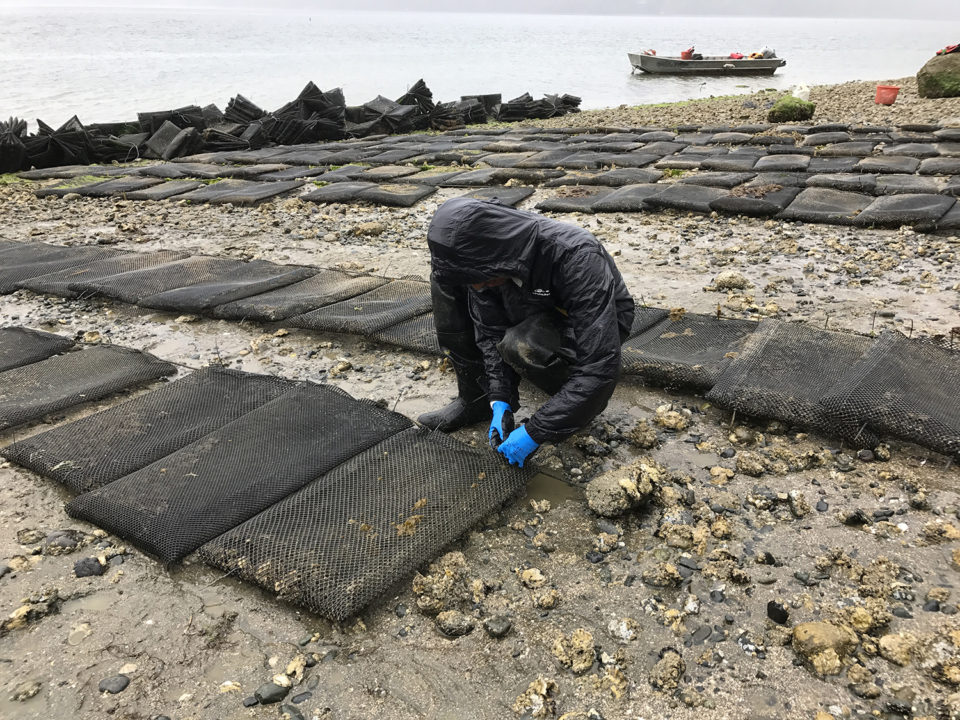Physical trait-selection technology could help prevent herpes virus outbreaks and enhance selective breeding

For farmers of Pacific and European flat oysters, a new genetic tool promises to help resolve losses caused by the oyster herpes virus (Ostreid herpesvirus-1).
Dr. Ross Houston, lead researcher at the University of Edinburgh’s Roslin Institute, said mortalities to the virus are high in individual outbreaks, sometimes up to 90 percent, although the exact number of losses, as well as the frequency of outbreaks, varies substantially from year to year.
Houston’s team of 10 researchers spent the past two years developing a chip that can measure small genetic variations in oyster DNA. The chip is loaded with tens of thousands of pieces of DNA, each carrying a fragment of the oyster’s genetic code.

Using a DNA sample from each oyster, the chip can measure small genetic variations (Single Nucleotide Polymorphisms) linked to physical traits. Initially, the chip will be used to identify oysters resistant to the herpes virus, but in the future it may be able to identify oysters with other desirable characteristics, such as faster growth rates.
Each chip costs $50 and while it’s available now, Houston said studies using the chip will likely be required before breeders and farmers can apply the technology. Since details of the research were published in the journal G3: Genes, Genomes, Genetics in May 2017, the response has been considerable.
“We’ve had significant interest from scientists and farmers in several countries, and several other groups in the UK and New Zealand are using the technology,” he said. “There has been interest from groups in North America, so I suspect this tool or similar technology will be applied there, soon.”
Dr. Benoit Eudeline, director of research and the molluscan broodstock program at Taylor Shellfish Co. in Shelton, Wash., is one of the researchers in contact with Houston and his team, and is well aware of the devastating effects of the virus.
“Everywhere the oyster herpes virus has shown up the industry gets decimated and it can take up to 10 years to get back to economically viable levels of production,” he said. “We’re trying to protect ourselves as much as possible.”
Eudeline said selective breeding for better growth survival is one of the components of Taylor’s broodstock program, and while he could not divulge much information, he said the company recently started collaborating with different entities.
“Part of our worry is the herpes virus and selecting oysters resistant to it. That’s not easy because we don’t want herpes anywhere here – so the selection has to be done remotely, using partners whose oysters have herpes. It’s expensive, but still worth creating this collaboration because the end goal is to have a line of oysters that are resistant, just in case herpes shows up.”
The hope is that with improved studies in the field, oyster farmers will be able to selectively breed shellfish for traits including resistance to disease.
Eudeline agreed that tools such as this one will be the future of oyster breeding. The United States has been one of the few strongholds without the oyster herpes virus and the industry is working together to ensure it stays that way, he added.
“We’re making sure there’s a lot of regulation preventing the introduction of iffy brood stock from unknown areas, because we want to prevent an outbreak at all costs,” said Eudeline.
While oyster farmers didn’t request the development of the genetic tool, it was created in collaboration with an oyster farming company, Houston said.
“The impetus was to enable improved research relating to genetics and breeding in oysters, with downstream benefits for farmers, and the hope is that with improved studies in the field, oyster farmers will be able to selectively breed shellfish for traits including resistance to disease,” he said.
While it’s too early to tell what this tool’s potential impact on the industry will be, Houston is hopeful: “Any improvement to resistance to herpes virus in oysters through breeding is very desirable, and the subject of research programs in many countries.”
Funded by the Biotechnology and Biological Sciences Research Council in the UK, the project involved researchers from the Centre for Environment Fisheries and Aquaculture Science and Edinburgh Genomics.
Follow the Advocate on Twitter @GAA_Advocate
Author
-
Lauren Kramer
Lauren Kramer is a freelance journalist residing in Richmond, B.C., who has written extensively about seafood marketing for SeaFood Business magazine and SeafoodSource.com. Her work appears in a number of business journals, including Bellingham Whatcom County Tourism, USA National Culinary Review, Flavor & The Menu and many others.
Tagged With
Related Posts

Health & Welfare
Aquaculture disease experts to download at GOAL 2016
At this year’s GOAL conference in Guangzhou, China, leading animal welfare and aquatic animal disease experts will share knowledge about how producers can gird their operations. EMS, EHP, streptococcosis and sea lice will be addressed, as will the latest in area management.

Intelligence
As ocean temperatures rise, so too will vibrio outbreaks
A study using a half-century of data has linked climate change and warming sea temperatures with an increase in illnesses from the common vibrio bacteria. Shellfish growers, fighting a particularly virulent strain of Vibrio parahaemolyticus, are changing their harvest protocols.

Intelligence
Farm, plant and hatchery: The Taylor Shellfish experience
The Global Aquaculture Advocate toured Taylor Shellfish Co. operations in Puget Sound following the SeaWeb Seafood Summit, which was held in nearby Seattle. Taylor, one of the leading U.S. shellfish suppliers, offered conference attendees an up-close look at its farming, processing and hatchery operations.

Intelligence
Behold the nutritious oyster
Oysters provide important, natural filtration of water and are an important component of many healthy coastal ecosystems because their active filtering can help improve and maintain water quality. For many coastal communities, oysters are an important food resource and excellent sources of protein and amino acids, zinc, selenium, iron and B-vitamins.


